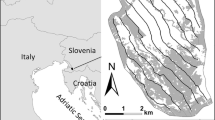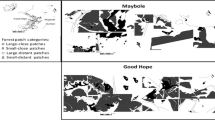Abstract
In fragmented landscapes, agroforest woodlots can potentially act as stepping stones facilitating movement between forest fragments. We assessed the influence of agroforest woodlots on bird distribution and diversity in the Atlantic forest region (SE Brazil), and also tested which categories of species can use different types of connection elements, and whether this use is influenced by the distance to large forest patches. We studied two fragmented landscapes, with and without stepping stones linking large fragments, and one forested landscape. Using a point count, a bird survey was undertaken in the fragmented landscapes in five different elements: large remnants (>400 ha), agroforest woodlots (0.4–1.1 ha), small patches (0.5–7 ha), riparian corridor, and pasture areas (the main matrix). Generalist and open-area species were commonly observed in the agroforest system or other connection elements, whereas only a few forest species were present in these connections. For the latter species, the distance of woodlots to large patches was essential to determine their richness and abundance. Based on our results and data from literature, we suggest that there is an optimal relationship between the permeability of the matrix and the efficiency of stepping stones, which occurs at intermediate degrees of matrix resistance, and is species-dependent. Because the presence of agroforest system favors a higher richness of generalist species, they appeared to be more advantageous for conservation than the monoculture system; for this reason, they should be considered as a management alternative, particularly when the matrix permeability requirement is met.






Similar content being viewed by others
References
Åberg J, Jansson G, Swenson JE, Angelstam P (1995) The effect of matrix on the occurrence of hazel grouse (Bonasa bonasai) in isolated habitat framents. Oecologia 103:265–269
Acharya KP (2006) Linking trees on farms with biodiversity conservation in subsistence farming systems in Nepal. Biodivers Conserv 15:631–646
Adriaensen F, Chardon JP, De Blust G, Swinnen E, Villalba S, Gulinck H, Matthysen E (2003) The application of ‘least-cost’ modelling as a functional landscape model. Landsc Urban Plan 64:233–247
Antongiovanni M, Metzger JP (2005) Influence of matrix habitats on the occurrence of insectivorous bird species in Amazonian forest fragments. Biol Conserv 122:441–451
Baum KA, Haynes KJ, Dillemuth FP, Cronin JT (2004) The matrix enhances the effectiveness of corridors and stepping stones. Ecology 85:2672–2675
Beier P, Noss RF (1998) Do corridors provide connectivity? Conserv Biol 12:1241–1252
Bélisle M, Desrochers A (2002) Gap-crossing decisions by forest birds: an empirical basis for parameterizing spatially-explicit, individual-based models. Landsc Ecol 17:219–231
Beyer DD (2006) O papel dos bosques agroflorestais para a diversidade da avifauna na paisagem fragmentada do Pontal do Paranapanema, SP – Brasil. São Paulo, Dissertação de Mestrado PROCAM/Universidade de São Paulo, 61 pp
Blondel J, Chessel Ferry C, Frochot B (1970) La méthode des indices ponctuels d´abondance (I.P.A.) ou des relevés d´avifaune par “stations d´écoute”. Alauda 38:55–71
Brooks TM, Pimm SL, Oyugi JO (1999) Time lag between deforestation and bird extinction in tropical forest fragments. Conserv Biol 13:1140–1150
Colwell RK, Coddington JA (1994) Estimating terrestrial biodiversity through extrapolation. Philos Trans: Biol Sci 345:101–118
Conservation International (2000) Designing a sustainable landscape: the Brazilian Atlantic Forest
Cullen L Jr, Schimink M, Valladares-Pádua C, Morato I (2001) Agroforestry benefit zones: a tool for the conservation management of Atlantic Forest fragments, São Paulo, Brazil. Nat Areas J 21:346–356
Damschen EI, Haddad NM, Orrock JL, Tewksbury JJ, Levey DJ (2006) Corridors increase plant species richness at large scales. Science 313:1284–1286
Dean W (1996) A Ferro e Fogo – A história e a devastação da Mata Atlântica brasileira. Companhia das Letras, São Paulo
Didham RK, Lawton JH (1999) Edge structure determines the magnitude of changes in microclimate and vegetation structure in tropical forest fragments. Biotropica 31:17–30
Estrada A, Cammarano P, Coates-estrada R (2000) Bird species richness in vegetation fences and in strips of residual rain forest vegetation at Los Tuxtlas, Mexico. Biodivers Conserv 9:1399–1416
Faria D, Laps RR, Baumgarten J, Cetra M (2006) Bat and bird assemblages from forests and shade cacao plantations in two contrasting landscapes in the Atlantic Forest of southern Bahia, Brazil. Biodivers Conserv 15:587–612
Ferrari Leite J (1998) A ocupação do Pontal do Paranapanema. Ed. Hucitec, Fundação UNESP, São Paulo
Fischer J, Lindenmayer DB (2002a) The conservation value of paddock trees for birds in a variegated landscape in southern New South Wales. 1. Species composition and site occupancy patterns. Biodivers Conserv 11:807–832
Fischer J, Lindenmayer DB (2002b) The conservation value of paddock trees for birds in a variegated landscape in southern New South Wales. 2. Paddock trees as stepping stones. Biodivers Conserv 11:833–849
Francisco MR, Galetti M (2002) Aves como potenciais dispersoras de sementes de Ocotea pulchella Mart. (Lauracea) numa área de vegetação de cerrado do sudeste brasileiro. Rev Bras Bot 25:11–17
Garlindo-Gonzalez J, Guevara S, Sosa VJ (2000) Bat- and bird-generated seed rains at isolated trees in pastures in a tropical rainforest. Conserv Biol 14:1693–1703
Gotelli NJ, Colwell RK (2001) Quantifying biodiversity: procedures and pitfalls in the measurement and comparison of species richness. Ecol Lett 4:379–391
Graham CH (2001) Factors influencing movement patterns of keel-billed toucans in a fragmented tropical landscape in southern Mexico. Conserv Biol 15:1789–1798
Guevara S, Laborde J (1993) Monitoring seed dispersal at isolated trees in tropical pastures: consequences for local species avalability. Vegetatio 107/108:319–338
Haddad NM, Baum KA (1999) An experimental test of corridor effects on butterfly densities. Ecol Appl 9:623–633
Hanski I, Gilpin ME (1997) Metapopulation biology: ecology, genetics, and evolution. Academic Press, San Diego
Harvey CA, Villanueva C, Villacís J, Chacón M, Muñoz D, López M, Ibrahim M, Gómez R, Taylor R, Martinez J, Navas A, Saenz J, Sánchez D, Medina A, Vilchez S, Hernández B, Perez A, Ruiz F, López F, Lang I, Sinclair FL (2005) Contribution of live fences to the ecological integrity of agricultural landscapes. Agriculture Ecosystems and Environment
Harvey CA, Gonzalez J, Somarriba E (2006) Dung beetle and terrestrial mammal diversity in forests, indigenous agroforestry systems and plantain monocultures in Talamanca, Costa Rica. Biodivers Conserv 15:555–585
Laurance WF, Lovejoy TE, Vasconcelos HL, Bruna EM, Didham RK, Stouffer PC, Gascon C, Bierregaard RO, Laurance SG, Sampaio E (2002) Ecosystem decay of Amazonian Forest fragments: a 22-year investigation. Conserv Biol 16:605–618
León MC, Harvey CA (2006) Live fences and landscape connectivity in a neotropical agricultural landscape. Agroforestry Syst 68:15–26
Lindenmayer DB, Franklin JF, Fischer J (2006) General management principles and a checklist of strategies to guide forest biodiversity conservation. Biol Conserv 131:433–445
Kupfer JA, Malanson GP, Franklin SB (2006) Not seeing the ocean for the islands: the mediating influence of matrix-based processes on forest fragmentation effects. Global Ecol Biogeogr 15:8–20
MacArthur RH, Wilson EO (1967) The theory of island biogeography, monographs in population biology. Princeton Univ. Press, Princeton
Manning AD, Fischer J, Lindenmayer DB (2006) Scattered trees as keystones structures – implication for conservation. Biol Conserv 132:311–321
Mesquita RCG, Delamonica P, Laurance WF (1999) Effects of surrounding vegetation on edge-related tree mortality in Amazonian forest fragments. Biol Conserv 91:129–134
Metzger JP (1999) Estrutura da paisagem e fragmentação: análise bibliográfica. Anais da Academia Brasileira de Ciências 71:445–463
Mittermeier RA, Myers N, Gil PR, Mittermeier CG (1999) Hotspots: earth’s biologically richest and most endangered terrestrial ecoregions. CEMEX, Mexico City
Murphy HT, Lovett-Doust J (2004) Context and connectivity in plant metapopulations and landscape mosaics: does the matrix matter? Oikos 105:3–14
Oliveira JB, Camargo MN, Rossi M, Calderano Filho B (1999) Mapa Pedológico do Estado de São Paulo: legenda expandida. Campinas: Instituto Agronômico: Rio de Janeiro, Embrapa Solos, Campinas
Oliveira-Filho AT, Fontes MAL (2000) Patterns of floristic differentiation among Atlantic Forests in southeastern Brazil and influence of climate. Biotropica 32:793–810
Orrock JL, Danielson BJ, Burns MJ, Leveyc DJ (2003) Spatial ecology of predator prey interactions: corridors and patch shape influence seed predation. Ecology 84:2589–2599
Pardini R (2004) Effects of forest fragmentation on small mammals in an Atlantic Forest landscape. Biodivers Conserv 13:2567–2586
Pardini R, Marques de Souza S, Braga-Neto R, Metzger JP (2005) The role of forest structure, fragment size and corridors in maintaining small mammal abundance and diversity in an Atlantic forest landscape. Biol Conserv 124:253–266
Parker III TA, Stotz DF, Fitzpatrick JW (1996) Ecological and distributional databases. In: Stotz DF, Fitzpatrick JW, Parker III TA, Moskovits DK (eds) Neotropical birds: ecology and conservation. The University of Chicago Press, Chicago, pp 111–410
Raman TRS (2006) Effects of habitat structure and adjacent habitats on birds in tropical rainforest fragments and shaded plantations in the western ghats, India. Biodivers Conserv 15:1577–1607
Renjifo LM (2001) Effect of natural and anthropogenic landscape matrices on the abundance of subandean bird species. Ecol Appl 11:14–31
Rosenberg DK, Noon BR, Meslow EC (1997) Biological corridors: form, function, and efficacy. BioScience 47:677–687
Ross JL, Moroz IC (1997) Mapa Geomorfológico do Estado São Paulo (relatório e mapas) 1:500.000. Vols. 1 and 2. IPT, São Paulo
Saunders DA (1994) Can we integrate nature conservation with agricultural production? Landsc Urban Plan 28:55–62
Sick H (1997) Ornitologia brasileira. Editora Nova Fronteira S.A., Rio de Janeiro
Taylor PD, Fahrig L, Henein K, Merriam G (1993) Connectivity is a vital element of landscape structure. Oikos 69:571–573
Tewksbury JJ, Levey DJ, Haddad NM, Sargent S, Orrock JL, Weldon A, Danielson BJ, Brinkerhoff J, Damschen EI, Townsend P (2002) Corridors affect plants, animals, and their interactions in fragmented landscapes. Proc Nat Acad Sci 99:12923–12926
Thiollay J (2005) The role of traditional agroforests in the conservation of rain forest bird diversity in Sumatra. Conserv Biol 9:335–353
Uezu A, Metzger JP, Vielliard JM (2005) The effect of structural and functional connectivity and patch size on the abundance of seven Atlantic Forest bird species. Biol Conserv 123:507–519
Vielliard J, Silva WR (1990) Nova Metodologia de Levantamento Quantitativo da Avifauna e Primeiros Resultados do Interior do Estado de São Paulo, Brasil. In: Anais do IV Encontro Nacional dos Anilhadores de Aves, Universidade Federal Rural de Pernambuco, Recife, pp 117–151
Zar JH (1996) Biostatistical analysis. Prentice Hall, Upper Saddle River
Acknowledgements
We thank Maria Ogrzewalska, Pedro Develey, Miguel Â. Marini, Paulo Inácio Prado, Wesley Silva, Janet W. Reid and an anonymous reviewer for revising this manuscript. We are also grateful for the cooperation of the staff of IPÊ – Institute for Ecological Research who had created the agroforest woodlots and make this work possible, and also helped us to select the study areas. Financial support was provided by FAPESP (The State of São Paulo Research Foundation, process no. 02/01746-1), Idea Wild and Association of Field Ornithologists.
Author information
Authors and Affiliations
Corresponding author
Rights and permissions
About this article
Cite this article
Uezu, A., Beyer, D.D. & Metzger, J.P. Can agroforest woodlots work as stepping stones for birds in the Atlantic forest region?. Biodivers Conserv 17, 1907–1922 (2008). https://doi.org/10.1007/s10531-008-9329-0
Received:
Accepted:
Published:
Issue Date:
DOI: https://doi.org/10.1007/s10531-008-9329-0




